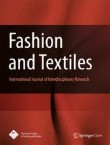Fashion and Textiles is affiliated with The Korean Society of Clothing and Textiles
Opportunities and challenges of smart technology for small independent fashion retailers: a reflexive thematic analysis using the technology-organization-environment framework
Smart technology has become an increasingly prominent feature in the fashion apparel industry. However, small retailers still face challenges while trying to adopt such innovative smart technologies to increas...
